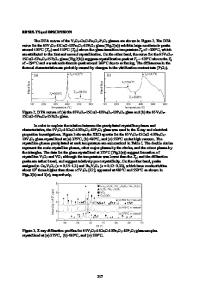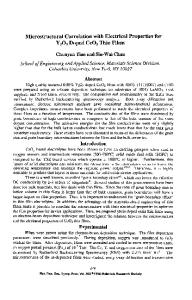Compositional Effects and Optical Properties of P 2 O 5 Doped Magnesium Silicate Mesoporous Thin Films
- PDF / 5,339,205 Bytes
- 14 Pages / 595.276 x 790.866 pts Page_size
- 15 Downloads / 399 Views
RESEARCH ARTICLE-PHYSICS
Compositional Effects and Optical Properties of P2 O5 Doped Magnesium Silicate Mesoporous Thin Films Amany M. El Nahrawy1 · Ali B. Abou Hammad1 · A. M. Mansour1 Received: 3 June 2020 / Accepted: 23 October 2020 © King Fahd University of Petroleum & Minerals 2020
Abstract Mesoporous P2 O5 doped magnesium silicate (MS-P) thin films were prepared using the activated sol–gel method and calcinated at different temperatures (200, 300, and 400 °C). The effect of both P2 O5 content, and the calcinating temperature on the thin films structure, morphology, FTIR, and UV–Vis optical properties, was examined. The structural results demonstrate that the changing of the P2 O5 content ratio and the temperature of preparation have significant effects on crystallization and the internal structure. All films were found to have a relative value of transmittance that reaches or exceeds about 90% in the visible range. The optical band gap shows a blue shift with increasing of the P2 O5 content as well as with calcinating temperature increase. The refractive index is nearly constant and uniform in the overall visible zone for all samples. The optical conductivity shows nearly relative values and similar behaviors in all P2 O5 contents at all calcinating temperatures, where it is constant at low energies and increases at higher incident photon energies. Keywords Magnesium silicate · Phosphate · Sol–gel · Mesoporous · Thin films · Optical
1 Introduction Due to their exact interesting photoluminescence, optical, biomedical and electrical properties in combination with their non-toxicity, non-hygroscopic nature, and lower cost, optical materials containing P2 O5 have been well regarded as low-temperature glasses of the scientific and technological fields [1–3]. Because of their interest in laser, optoelectronics, and fiber optics applications, developments in the physical properties of the silicate network have been studied widely [4, 5]. It is well-known that the phosphate glasses exhibited unique properties such as low optical basicity, softening temperature, high thermal expansion coefficients, low refractive index, high electrical conductivity, low glass transition, and High transparency range (185 nm–3 μm) have produced various optical applications including fast ion-conducting materials, solid-state electrolytes, high-performance lasers, biocompatible engineering materials [6, 7]. Moreover, the problems connected with Phosphate glasses may limit their
B 1
A. M. Mansour [email protected] Solid-State Physics Department, Physics Research Division, National Research Centre, 33 El-Bohouth St., Dokki, Giza 12622, Egypt
application in future industrial and electronic devices. Otherwise, the chemical durability and structure of the phosphate system could be developed by doping or adding another glass former and various modifiers similar to Al2 O3 , SiO2 , Co2 O3 , ZnO, MgO, and rare earth ions [8–10]. The optical silicate/phosphate glasses are of particular interest as hosts for rare earth ions where it merges
Data Loading...










